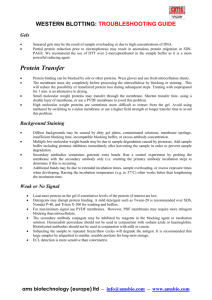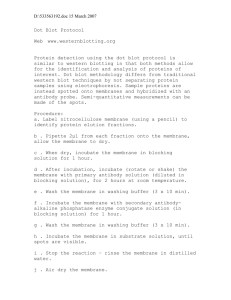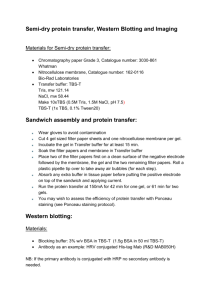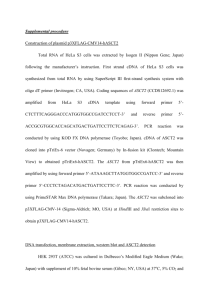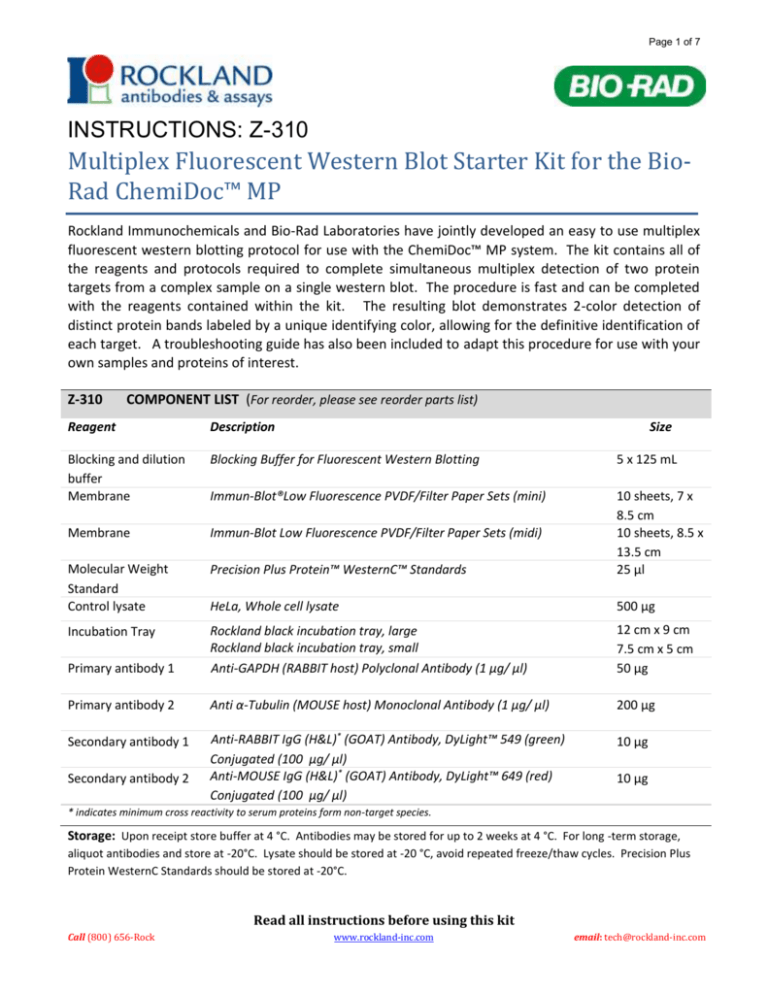
Page 1 of 7
INSTRUCTIONS: Z-310
Multiplex Fluorescent Western Blot Starter Kit for the BioRad ChemiDoc™ MP
Rockland Immunochemicals and Bio-Rad Laboratories have jointly developed an easy to use multiplex
fluorescent western blotting protocol for use with the ChemiDoc™ MP system. The kit contains all of
the reagents and protocols required to complete simultaneous multiplex detection of two protein
targets from a complex sample on a single western blot. The procedure is fast and can be completed
with the reagents contained within the kit. The resulting blot demonstrates 2-color detection of
distinct protein bands labeled by a unique identifying color, allowing for the definitive identification of
each target. A troubleshooting guide has also been included to adapt this procedure for use with your
own samples and proteins of interest.
Z-310
COMPONENT LIST (For reorder, please see reorder parts list)
Reagent
Description
Blocking and dilution
buffer
Membrane
Blocking Buffer for Fluorescent Western Blotting
5 x 125 mL
Immun-Blot®Low Fluorescence PVDF/Filter Paper Sets (mini)
Membrane
Immun-Blot Low Fluorescence PVDF/Filter Paper Sets (midi)
Molecular Weight
Standard
Control lysate
Precision Plus Protein™ WesternC™ Standards
10 sheets, 7 x
8.5 cm
10 sheets, 8.5 x
13.5 cm
25 µl
HeLa, Whole cell lysate
500 µg
Incubation Tray
Primary antibody 1
Rockland black incubation tray, large
Rockland black incubation tray, small
Anti-GAPDH (RABBIT host) Polyclonal Antibody (1 µg/ µl)
12 cm x 9 cm
7.5 cm x 5 cm
50 µg
Primary antibody 2
Anti α-Tubulin (MOUSE host) Monoclonal Antibody (1 µg/ µl)
200 µg
Secondary antibody 1
Anti-RABBIT IgG (H&L)* (GOAT) Antibody, DyLight™ 549 (green)
Conjugated (100 µg/ µl)
Anti-MOUSE IgG (H&L)* (GOAT) Antibody, DyLight™ 649 (red)
Conjugated (100 µg/ µl)
10 µg
Secondary antibody 2
Size
10 µg
* indicates minimum cross reactivity to serum proteins form non-target species.
Storage: Upon receipt store buffer at 4 °C. Antibodies may be stored for up to 2 weeks at 4 °C. For long -term storage,
aliquot antibodies and store at -20°C. Lysate should be stored at -20 °C, avoid repeated freeze/thaw cycles. Precision Plus
Protein WesternC Standards should be stored at -20°C.
Read all instructions before using this kit
Call (800) 656-Rock
www.rockland-inc.com
email: tech@rockland-inc.com
Page 2 of 7
Important Product Information
The Fluorescent Western Blotting Kit reagents are optimized to function together. For best results, use the
primary and secondary antibodies at the recommended dilutions.
Use a clean, dust free, incubation tray for each step of the Fluorescent Western Blotting procedure. For optimal
results, agitate solutions using a rocking or rotating platform during incubation and wash steps. Always wear
powder free gloves and use clean forceps to handle the blot. Please note that directly handling the blot, even
with gloves, may introduce artifacts during imaging.
All equipment must be clean and free of foreign material. Cover incubation trays to minimize the chance of dust
or other particulate matter sticking to the membrane, as this may cause blot artifacts or an increase in
background.
Use pencil when marking the blot, as the fluorescent properties of pen ink may interfere with blot imaging.
Additional Materials Required
Criterion TGX™ Precast gels (4-20% or AnykD recommended), Mini-PROTEAN® TGX™ Precast gels
(AnykD recommended) or a handcast gel and electrophoresis equipment and reagents (ie.Criterion™
Cell, Mini-PROTEAN® Tetra Cell, PowerPac™ Power Supply)*
Blotting Equipment (ie. Trans-Blot® Turbo™, Mini Trans-Blot® or Criterion™ Blotter , or Trans-Blot SD
Semi-Dry system)*
Blotting reagents (buffers, filter paper, or Trans-Blot Turbo Transfer packs)
Methanol (or ethanol) to wet the Immun-Blot LF PVDF membrane
Laemmeli Sample Buffer (to dilute the WesternC Standards)
Membrane wash buffer composed of Tris-buffered saline with Tween-20 (final concentration of 0.05 %)
to reduce nonspecific signal
Western Blot incubation tray
Forceps to handle the membrane
Rotary or rocking platform shaker for agitation of membrane during incubations.
*This kit is compatible with standard western transfer protocols such as tank or semi-dry as well as the rapid
protocols used by the Trans-Blot Turbo system. Use any suitable protocol to separate proteins by
electrophoresis and transfer them to the enclosed Immun-Blot LF PVDF membrane.
Protocol Overview
a) Complete electrophoresis with a Criterion TGX precast gel or a Mini-PROTEAN TGX precast gel to
separate the sample to be analyzed
b) Transfer the gel to an Immun-Blot LF PVDF membrane using the Trans-Blot Turbo or other western blot
transfer device
c) Block the membrane with Rockland Blocking Buffer for Fluorescent Western Blotting
d) Probe the membrane simultaneously with Rockland mouse and rabbit host primary antibodies
e) Detect simultaneously with anti-mouse and anti-rabbit Rockland DyLight™ conjugated secondary
antibodies
f)
Image and analyze the blot on the ChemiDoc MP
Call (800) 656-Rock
www.rockland-inc.com
email: tech@rockland-inc.com
Page 3 of 7
Kit Principle
This kit supplies reagents for simultaneous, 2-color, multiplex detection of two separate targets in a HeLa lysate
sample. The provided antibodies for rabbit anti-GAPDH and mouse anti-tubulin are be combined prior to
incubation of the blotting membrane, allowing for parallel detection of these targets without the need for
stripping and reprobing the membrane. Protein targets are detected using provided DyLight™549 conjugated
Goat anti-Rabbit antibody (green) and DyLight™649 conjugated Goat anti-Mouse secondary antibody (red).
Both conjugates are highly cross-absorbed to prevent cross-channel fluorescence. Additionally the kit provides
Immun-Blot LF PVDF membrane, blocking and dilution buffers optimized for fluorescence blotting applications.
The labeled antibodies are detected directly on the membrane using the multichannel imaging capabilities of
the ChemiDoc MP system, thus eliminating film, darkrooms, and messy substrates, while preserving high
sensitivity. Two-color analysis of proteins on one blot results in faster and more precise measurements of
proteins. The procedures and reagents included in this kit are typical of fluorescent blotting procedures and can
be adapted as needed for the Researcher’s own experiments (see troubleshooting section below). A schematic
illustration of the enclosed multiplex western blot is shown in figure 1.
Figure 1 Schematic for 2-color multiplex western blot. After SDS-PAGE and transfer to PVDF membrane, GAPDH is
detected by a rabbit anti-GAPDH and the DyLight™ 549 (GREEN) conjugated Goat anti-rabbit secondary antibody.
Tubulin is detected by a mouse anti-Tubulin and the DyLight™ 649 (RED) Goat anti-mouse secondary antibody. Data
for the immune complex is collected on the ChemiDoc MP.
Call (800) 656-Rock
www.rockland-inc.com
email: tech@rockland-inc.com
Page 4 of 7
Protocol
1. Prepare buffers:
- TBS: 20mM Tris-HCl, 500mM Sodium Chloride pH 7.5
- TTBS: TBS with 0.05% Tween-20
2. Sample Preparation and Gel Electrophoresis:
- For the HeLa lysate, prepare by adding 10 µl 2-mercaptoethanol (final concentration of 5%).
Alternatively dithiothreitol at 100 mM may be substituted for 2-mercaptoethanol. Heat sample to 95100 °C for 4 - 5 min. Allow sample to cool, and microfuge at maximum RPM for 1 minute.
- Dilute the Precision Plus Protein WesternC Standards 1:10 (i.e. add 225 µl of Laemmeli Sample Buffer
to the 25 µl sample) and load 5 µl of the diluted standard. Load 20 µl of HeLa lysate onto gel. Perform
separation using a TGX Stain Free gel at 300V until the dye front reaches the J-foot (Criterion) or within 2
mm of the indicator line (Mini-PROTEAN).
3. Western Blot Transfer:
- Pre-wet Immun-Blot LF PVDF membrane in 100% methanol (or ethanol) for 30 seconds then
submerge the wetted membrane in water or transfer buffer for 5 min in order to remove the methanol.
- Assemble the transfer apparatus according to manufacturer’s instructions. For the Trans-Blot Turbo,
transfer using Trans-Blot Turbo Transfer Packs, replace the included membrane with wetted Immun-Blot
LF PVDF membrane.
- Transfer using manufacturer’s time and power recommendations for the specific gel type.
- After transfer disassemble blot apparatus. Carefully recover the membrane to keep it wet*.
*If the membrane shows any signs of drying, rewet it in methanol then wash in water or transfer buffer as described above.
4. Membrane Blocking:
- Quickly transfer the blot into 20 mL of fluorescent western blocking buffer*
- Block membrane for 1 hour with agitation at room temperature (20-25 °C).
*Blocking buffer should be sufficient in volume to completely cover the membrane. Use a container of the appropriate size
for the membrane to ensure that reagents are not wasted. Note, if required, the membrane can be blocked overnight at 4°C
5. Primary Antibody Incubation:
- Dilute both antibodies into 20 mL of blocking buffer according to the recommendations in the table
below.
Primary antibody
Dilution
Primary antibody 1
Anti-GAPDH (RABBIT host) Polyclonal Antibody
1:4000
Primary antibody 2
Anti α-Tubulin (MOUSE host) Monoclonal Antibody
1:1000
Call (800) 656-Rock
www.rockland-inc.com
email: tech@rockland-inc.com
Page 5 of 7
- Discard the blocking buffer from the previous step
- Quickly add the primary antibody solution to the membrane (to avoid drying the membrane) and
incubate with agitation for 1 hour at room temperature (or overnight at 4 °C).
- Discard the primary antibody solution and wash the membrane with 40mL of TTBS Wash Buffer for 5
minutes with agitation at room temperature
- Repeat the wash step two additional times
6. Secondary Antibody Incubation:
- Dilute both antibodies into 20 mL of blocking buffer according to the recommendations in the table
below.
Antibody Conjugate
Dilution
*
Secondary antibody 1
Anti-RABBIT IgG (H&L) (GOAT) Antibody,
DyLight™ 549 Conjugated
1:2000
Secondary antibody 2
Anti-MOUSE IgG (H&L)* (GOAT) Antibody,
DyLight™ 649 Conjugated
1:2000
- Discard the wash buffer from the previous step
- Quickly add the secondary antibody solution to the membrane (to avoid drying the membrane) and
incubate with agitation for 30 minutes at room temperature. Keep membrane out of direct sunlight.
- Discard the secondary antibody solution and wash the membrane with 40 mL of TTBS Wash Buffer for
5 minutes with agitation at room temperature
- Repeat the wash step two additional times
7. Membrane Drying:
- Discard the wash solution and soak the membrane in de-ionized water for 1 minute
- Transfer the membrane to 100% methanol for 30 seconds
- Remove membrane using forceps and allow to fully air-dry
- For extended storage, keep membrane out of direct sunlight
8. Blot Imaging Using the ChemiDoc MP:
- Center blot on ChemiDoc MP UV transillluminator
- Create a Multichannel Protocol. See Table 3 for application settings
Table 3. Fluorescent detection settings for ChemiDoc™ MP
Call (800) 656-Rock
Application
DyLight™ 650 (red)
Excitation (nm)
625
Emission Filter (bandpass)
695
DyLight™ 549 (green)
530
605
www.rockland-inc.com
email: tech@rockland-inc.com
Page 6 of 7
- Set Auto Image Exposure for “Intense bands”
- Set Imaging Area to “Bio-Rad Criterion Gel” (for midi gels) or “Bio-Rad Mini-PROTEAN Gel” (for mini
gels)
- Use “Position Gel” to check the image area and adjust the position of the blot if needed
- Click “Run Protocol” to image the blot
- The blot image should look similar to Figure 2 (below)
Figure 2 Expected 2-color multiplex data collected on the ChemiDoc MP. When properly performed, this
protocol should provide data similar to the image shown above.
Tips for Adapting Other Systems to Multiplex Fluorescent Detection:
- Use primary antibodies from different host species (for example, mouse and rabbit). Antibodies produced
from two closely related species such rat and mouse often demonstrate cross-reactivity with the secondary
antibody, even when the antibodies are cross-adsorbed.
- Use secondary antibodies that are highly cross-adsorbed against other species to avoid cross-reactivity.
- Use fluorophores conjugated to secondary antibodies with distinct spectra so they can be optically
distinguished from each other to avoid cross-channel fluorescence.
Call (800) 656-Rock
www.rockland-inc.com
email: tech@rockland-inc.com
Page 7 of 7
- Always optimize the detection of each target singly, before simultaneous detection of multiple targets. Since
some primary antibodies may be non-specific and yield multiple bands on a blot, single target detection will help
determine the banding pattern of each antibody prior to a multiplex experiment.
- Most membranes show higher background with shorter wavelength light. Detect your strongest target in the
blue channel, your middle target in green and reserve the red channel for your weakest target.
Related Products
For more information about Rockland products or custom services please visit www.rockland-inc.com.
For more information about these and other Bio-Rad products, visit us on the Web at discover.bio-rad.com.
DyLight™ is a trademark of Thermo Fisher Scientific Inc. and its subsidiaries.
This document is copyrighted. All rights are reserved. This document may not, in whole or part, be copied,
photocopied, reproduced, translated, or reduced to any electronic medium or machine-readable form without
prior consent, in writing, from Rockland Immunochemicals, Inc. ©11/15/2011, Rockland Immunochemicals,
Inc., Gilbertsville, PA, USA. All rights reserved.
Z-310
REORDER PARTS LIST
Reagent
Description
Size
Part Number
Blocking and dilution
buffer
Membrane
Blocking Buffer for Fluorescent Western Blotting
1 x 500mL
MB-070
Immun-Blot Low Fluorescence PVDF/Filter Paper Sets
(mini)
Immun-Blot Low Fluorescence PVDF/Filter Paper Sets
(midi)
Precision Plus Protein WesternC Standards (1:10
dilution)
HeLa, Whole cell lysate
10 sandwiches
162-0260
10 sandwiches
162-0262
25 µL
161-0376S
500 µg
W09-000-364
Rockland black incubation tray, large
Rockland black incubation tray, small
12 cm x 9 cm
7.5 cm x 5 cm
WIB-4625-005
WIB-2875-010
Primary antibody 1
Anti-Glyceraldehyde-3-Phosphate Dehydrogenase
(GAPDH) (RABBIT host) Antibody
100 µg
600-401-A33
Primary antibody 2
Anti α-Tubulin (MOUSE host) Monoclonal Antibody
100 µg
200-301-880
Secondary antibody 1
Anti-RABBIT IgG (H&L)* (GOAT) Antibody, DyLight™
549 (green) Conjugated
Anti-MOUSE IgG (H&L)* (GOAT) Antibody, DyLight™
649 (red) Conjugated
100 µg
611-142-122
100 µg
610-143-121
Membrane
Molecular Weight
Standard
Control lysate
Incubation Tray
Secondary antibody 2
Rev.0 (11/15/2011)
Call (800) 656-Rock
www.rockland-inc.com
email: tech@rockland-inc.com

